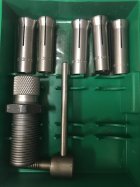Have you ever done a seating depth test with hand loads for that rifle? Seating depth can be a very big deal when it comes to precision, but I don't have any experience with the potential magnitude of the effect in pistol cartridges and their relatively blunt-shaped bullets (as compared to long centerfire rifle bullets).
I have done similar experiments with regard to commercial rifle ammunition. Even commercial ammunition that shoots quite well across a wide range of rifles (i.e. FGMM) had what seemed to me to be a stunning amount of variance in seating depth, perhaps as much as .008" to .010" across just a few rounds measured. To this day, I haven't figured out why that stuff shoots so well in some of my rifles. I can assure you that if any of my hand loads ever had that kind of seating depth variance, the results would be less than satisfactory.
If the bullets aren't crimped into the necks or sealed, one thing you could try would be to pick one of the shorter cartridges, measure CBTO (cartridge base-to-ogive), then seat the bullets in a few of the longer cartridges a little deeper to match and see how they worked. Of course, that doesn't necessarily mean that the seating depth of the shorter cartridges in the box is necessarily optimized for your rifle, but it would be a relative simple way to obtain several that all had the same seating depth and determine whether that had a noticeable effect. I would avoid using cartridge overall length (COAL) as the measure if possible, as individual bullet length variance within the loaded rounds can markedly affect the interpretation of the measurements, even when all the bullets are seated to approximately the same CBTO.
At under 50 fps (47 fps), the velocity variance you obtained using the two extremes in cartridge weight doesn't seem too bad to me for commercial ammunition. I can't tell from your follow-up post whether you ever directly weighed the powder in any of these shells, or how that velocity extreme spread might compare to your hand loads, but it seems unlikely to be the major cause of your group spreads at such a short distance (50 yd). You are correct in that the total weight variance between loaded rounds can come from weight variance within any of the individual components that make up the loaded rounds. As a general rule in such examples, the majority of the total weight variance is most likely to come from the heaviest components that make up the largest portion of the total weight; in this example that would likely be the bullets and cases. Based on your velocity extreme spread, it is probably safe to assume that the charge weight variance was a minor fraction of the total weight variance. Otherwise, the ES would have been noticeably larger.
In terms of determining exactly why the Precision One ammunition shoots so poorly in your rifle, the question I would ask is whether it's really worth the effort? Pulling and reloading a large number of rounds that you already paid for is not something I would undertake, due to the effort involved. Unless it was possible to re-seat the longer rounds to match the shortest as I mentioned above, and doing so actually had a noticeable effect on precision, I would simply buy one box each of several different brands of .44 ammunition and determine empirically what grouped the best, then buy more of that. If the current ammunition shortage is part of the problem, perhaps you sell the Precision One ammunition, or trade it to someone for a different brand that worked better in your setup.











